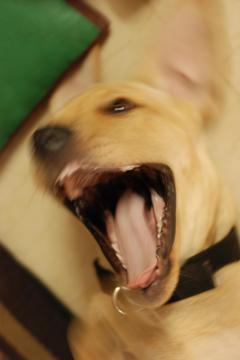As part of my “bite series”, I want to focus on the beginning – where it all starts. So, are dogs born biters or do they become biters? Do they learn to bite as they grow or are they born biters who learn not to bite? This question is a bit twisted. It’s like asking if a human learns to grasp another’s hand and break it or if a human is born with that knowledge.
Most humans are born with opposable thumbs. They do have innate ability to grasp that they quickly learn to use in different situations. Depending on the environment the human grows in, he or she learns the different contexts to use this particular dexterity and the contexts to refrain from using it. It’s not very different with dogs.
Dogs use their mouths like humans use their thumbs. They have excellent control over the amount of pressure they exert with their teeth and are able to be very precise with it. I have met dogs who are gentler when picking things up than a few clumsy people I have met. But the environment they are brought up in puts the meaning of this pressure in context for them. Their environment teaches them what is good and bad bite, just the way a human learns about good and bad touch.

Dogs learn the context and consequence of their bites early
Humans learn most of their early lessons exclusively from humans. Dogs on the other hand have evolved to learn from dogs as well as humans. Dogs can learn from their peers, littermates, friends, parents and humans about bite. One of the most valuable lessons dogs learn from all of them is “Bite Inhibition”. They learn to inhibit themselves on where to stop and what happens if they go too far.
One only needs to observe a pup at play to see how she learns bite inhibition. A pup is all teeth in her early days, grabbing on to everything that comes her way. She grabs on to her brother’s tail and bites. He finds it funny and bites back. They go on like this for a while till she goes a bit too far. He yelps out loudly and walks away sulking. She goes over to her sister and tries the same game and it ends up with her walking away dramatically as well. Then she goes to her mom. Her mommy indulges her for a while. But past a certain point her mommy is also not tolerating teeth. Though far less dramatic, mommy too walks away, leaving our little pup lonely and bored. For the onlooker, the pup may seem unperturbed by all of this. But the smart little puppy soon learns her most valuable lesson “too much bite == no fun, no play”. And thus emerges a graceful young lady with exquisite manners.
A human who has not deliberately developed a pup’s bite inhibition may wonder how to emulate this canine training. It’s surprisingly similar to the canine technique. And in most cases, it happens quite naturally. If our little puppy has arrived home before her mommy or littermates have had a chance to hone her manners, then she sets about biting her human friends. At first it’s all fun and play and the humans are oohing and aahing. But soon the bites start getting painful. Ideally the humans have to do exactly what mommy dog does and stop play at the first contact with teeth. But even if the humans are unaware of this and don’t do so, as our puppy gets big enough, the bite gets painful enough and the humans just stop finding it endearing. Play just stops. Dogs are smarter than we realize. They see the effect their bite is having on their human friends and they just learn. Thus bite inhibition just sets in – easy peasy!
So where does this system fail? There are a few rare but interesting situations where bite inhibition just does not set in. A typical example is in the case of very small dogs where the dog never gets large enough and the humans in question just don’t walk away from play when teeth are involved. The other is when a pup is growing up on the streets, but does not have canine company to learn from. This happens when big strong pedigree pups are abandoned on streets, do not assimilate into a group and grow up all on their own.
As social creatures ourselves, it should be easy for us to understand the need of dogs’ social circle to develop their social skills. Bite inhibition is one such very important social skill and it only develops when in sufficient social contact. So if we bring home a dog and are the dogs primary social circle, then the burden of that social training lies on us, irrespective of the size of the dog.
Do you remember your wee pup biting and that biting disappearing somewhere along the line? Do you remember what happened? How did that habit go away? Do share your story with me. I’d love to know.
And no one to help the poor tiger?!!
I sense discrimination.
Government-Orders-Shooting-of-Tiger-That-Killed-3-in-1-Week
http://newindianexpress.com/states/karnataka/Government-Orders-Shooting-of-Tiger-That-Killed-3-in-1-Week/2013/12/05/article1929012.ece